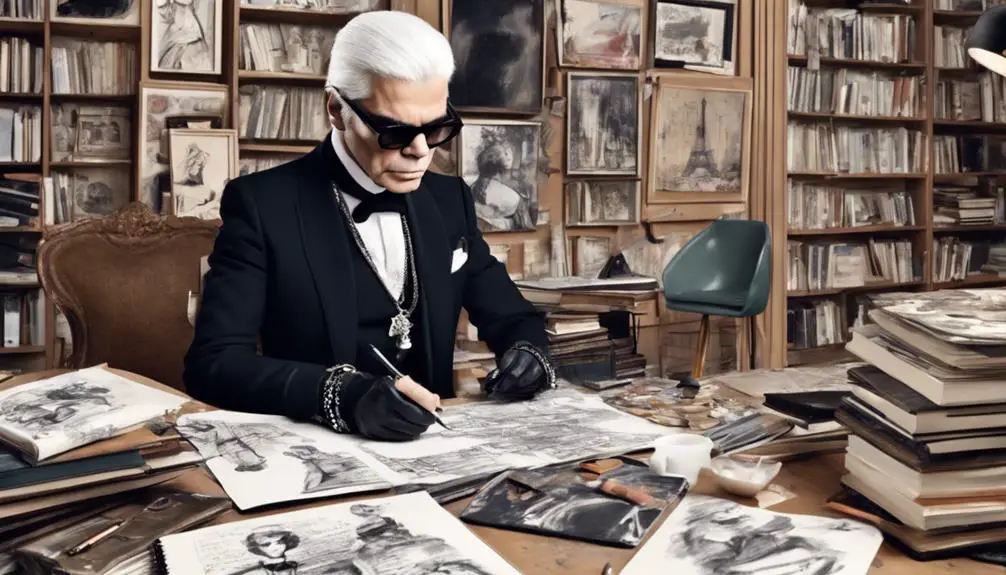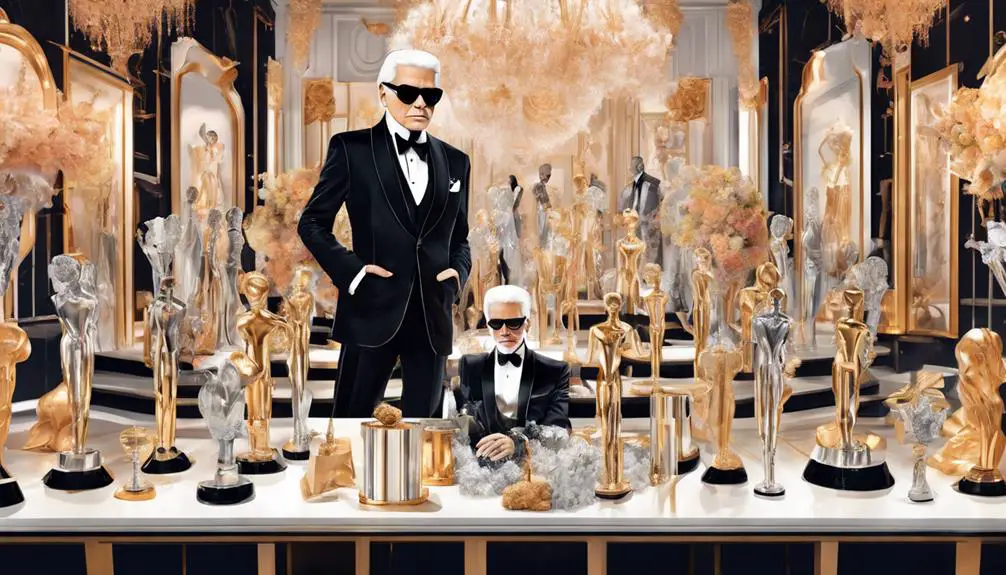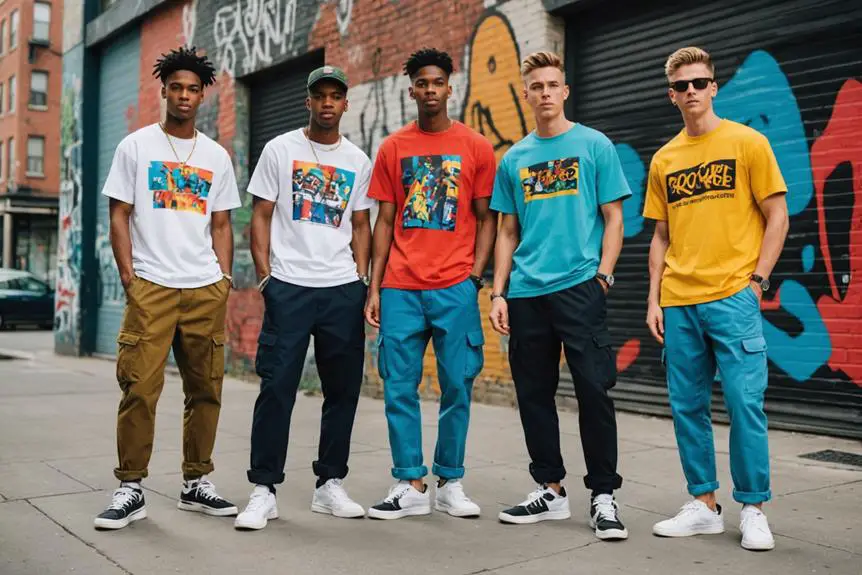When you delve into the essence of the Karl Lagerfeld brand, you uncover a narrative driven by ambition, creativity, and an unwavering commitment to innovation. From its inception in Hamburg to its influential role in the fashion industry, the brand embodies a distinct fusion of artistry and commercial savvy. Karl Lagerfeld's knack for adapting and redefining fashion trends has established the brand as a leader in the market. However, it is the brand's evolution and the compelling aspects of Lagerfeld's personal aesthetic that truly resonate. What inspired this iconic brand, and how have its choices shaped the fashion landscape we recognize today?
Early Life and Education

Karl Lagerfeld's journey in the world of fashion began on September 10, 1933, in Hamburg, Germany, where he was born into a wealthy family. Growing up in such an environment provided him with a unique perspective on entrepreneurship and style, thanks to his father's business acumen and his mother's lingerie sales. In 1952, at just 19, Karl took a bold step and moved to Paris, the fashion capital of the world, to pursue his aspirations.
He enrolled at Lycée Montaigne, immersing himself in drawing and art history, which would later be instrumental in shaping his innovative designs. In 1954, he entered the International Wool Secretariat competition and clinched first prize for his coat design, an achievement that marked his entry into the fashion industry and garnered significant attention.
The following year, in 1955, he secured a coveted position as an assistant to the renowned designer Pierre Balmain, a role that provided him with invaluable experience and connections crucial for his career. In 1964, Karl further enriched his artistic vision by traveling to Italy to study art history, a journey that profoundly influenced his distinctive style and creative direction in the fashion world.
Career Milestones and Innovations
Let's explore Karl Lagerfeld's career milestones and the remarkable innovations he brought to the fashion brand! From his early days at Jean Patou to redefining the aesthetic at Chanel, he truly knew how to make a bold statement. And who can overlook that transformative collaboration with H&M that revolutionized the way designers interact with the retail market?
Early Career Achievements
Entering the fashion world with remarkable talent and vision, the brand quickly made a name for itself through a series of significant career milestones. In 1954, it won the International Wool Secretariat design competition, which marked the beginning of its journey. This victory led to its first collaboration with Pierre Balmain in 1955. By 1957, the brand had appointed an artistic director, gaining recognition for its stunning haute couture contributions.
In 1965, the brand joined forces with Fendi, where it transformed the fur line, making it trendy and accessible. Then, in 1983, it launched its first couture collection for Chanel. This was a game-changer, revitalizing the brand and bringing it back to the forefront of fashion.
The brand didn't stop there! In 1984, it established its own eponymous label, showcasing a unique style and influence.
Here's a quick look at some of these milestones:
| Year | Milestone | Contribution |
|---|---|---|
| 1954 | Won International Wool Secretariat | Established recognition |
| 1955 | Collaboration with Pierre Balmain | Gained early experience |
| 1957 | Artistic director appointed | Haute couture acclaim |
| 1965 | Partnered with Fendi | Modernized fur designs |
| 1983 | Launched Chanel collection | Revitalized the brand |
Iconic Fashion Collaborations
Throughout its illustrious history, the fashion brand has forged numerous iconic collaborations that have greatly influenced the industry. Can you imagine the impact it has had? In 1965, the brand joined forces with Fendi, transforming their fur line under the guidance of a visionary creative director. This collaboration made luxury furs more accessible and stylish, setting the stage for future designs. Then, in 1983, it took the reins at Chanel, reviving the brand by blending contemporary styles with Coco Chanel's timeless designs that still resonate today.
But the brand didn't stop there. In 2004, it rocked the fashion world by teaming up with H&M, creating a collection that sold out faster than you could say "luxury fashion." This partnership made high fashion available to the masses and was truly revolutionary!
The creativity of the brand didn't just stick to clothing. It even ventured into lifestyle products, designing limited-edition Coca-Cola bottles in 2010 and introducing the fabulous Barbie Lagerfeld doll in 2014. Talk about versatility! These collaborations showcase the brand's influence beyond the runway, proving that fashion can be playful and accessible. Isn't that inspiring?
Innovative Design Techniques
Karl Lagerfeld's influence extended far beyond collaborations; his innovative design techniques reshaped the fashion landscape for his brand. You've got to appreciate how he became one of the first freelance fashion designers back in 1962. This move opened up creative freedom in the fashion industry, allowing designers to explore new horizons.
His Spring/Summer 1974 collection for Chloé? A whopping 200 looks! That was a game-changer for ready-to-wear fashion and set a new standard for the brand. Then, at Fendi, he revolutionized fur with stunning, innovative designs, making high-quality furs accessible to more people and elevating the brand's status. When he joined the Chanel brand in 1983, he didn't just revive it; he blended iconic styles with contemporary flair, introducing must-have pieces like the bouclé tweed jacket and the interlocking CC logo that became synonymous with the brand.
And let's not forget his extravagant fashion shows, where he turned every collection into a cultural spectacle, further solidifying the brand's influence in the fashion world.
Here's a little table to sum it up:
| Milestone | Impact on Brand | Legacy |
|---|---|---|
| First freelance designer | Greater creative freedom | Set the stage for modern design |
| 200 looks for Chloé | Revolutionized ready-to-wear | Expanded industry standards |
| Revitalized Chanel | Blended old and new | Iconic pieces that endure |
Isn't that inspiring?
Contributions to Chanel

In 1983, a transformative era commenced for Chanel when Karl Lagerfeld assumed the role of creative director, infusing the iconic brand with new energy and vision. How did he achieve this remarkable revival? Lagerfeld was no ordinary designer; he was a true innovator. He seamlessly integrated contemporary styles with Coco Chanel's timeless concepts, crafting a harmonious blend of the classic and the modern. His innovative approach echoed the groundbreaking changes introduced by designers like Giorgio Armani, who redefined fashion with distinctive design elements and reinforced brand identity through consistent branding and logo evolution.
Lagerfeld's inaugural haute couture collection was nothing short of revolutionary. It brought forth iconic pieces that would become staples in the fashion world, including:
- The bouclé tweed jacket
- The interlocking "CC" logo
- Elegant little black dresses
- Striking statement accessories
- Bold, vibrant colors
But Lagerfeld's contributions extended beyond just clothing. He pioneered the Mémoires d'Art runway shows, which celebrated the exceptional craftsmanship of Chanel's ateliers. These shows were not merely fashion presentations; they honored the artisans whose skills brought the designs to life. Additionally, Lagerfeld's groundbreaking fashion shows became legendary, featuring extravagant themes and innovative venues that redefined the way fashion was experienced—truly a visual feast!
Under Lagerfeld's leadership, Chanel achieved remarkable global visibility and financial success. The brand solidified its position as a leading luxury fashion house, making significant waves in the industry. He demonstrated that high fashion could be infused with fun and excitement, captivating both devoted fans and newcomers alike. It's astonishing how one visionary can alter the trajectory of a brand—this is the undeniable Karl Lagerfeld effect!
Personal Life and Transformation
Born on September 10, 1933, in Hamburg, Germany, the story of the fashion brand Karl Lagerfeld unfolds against the rich tapestry of design and innovation that emerged in the post-World War II era. As the brand grew, it became synonymous with cutting-edge style and elegance, yet its journey was marked by a unique personal narrative. One of the most influential figures behind the brand was Karl Lagerfeld himself, whose 18-year partnership with Jacques de Bascher played a significant role in shaping his creative vision. The profound loss of Jacques to AIDS in 1989 marked a pivotal moment for Lagerfeld, leading to a period of introspection that would ultimately influence his work.
In the 1990s, the brand experienced a remarkable evolution, largely driven by Lagerfeld's personal transformation. He embraced a new lifestyle, shedding over six stone within a year, which informed not only his health but also the aesthetic direction of his collections. This dedication to a healthier lifestyle resonated in the designs that emerged, characterized by sharp silhouettes and a striking palette of black and white — a reflection of Lagerfeld's own signature style, complete with white hair, black sunglasses, and fingerless gloves.
Yet, the brand's narrative extended beyond fashion and personal reinvention. Lagerfeld's affection for his beloved Birman cat, Choupette, became a whimsical symbol of the brand's identity. Her presence in his life inspired various collections and campaigns, showcasing a softer, more playful side of the brand. Choupette even became a muse, illustrating that the Karl Lagerfeld brand was not just about haute couture but also about a lifestyle that embraced both luxury and affection. Through these elements, the brand captured the hearts of many, demonstrating that even within the world of high fashion, there exists a tender and relatable narrative.
Awards and Legacy

Throughout its illustrious journey, the fashion brand has garnered numerous prestigious awards that reflect its innovative spirit and lasting impact on the industry. The brand's influence is evident through the accolades it has received, which not only celebrate its work but also inspire future generations in fashion.
- In September 2010, the brand was honored with the Couture Council Fashion Visionary Award.
- The Outstanding Achievement Award was presented at the British Fashion Awards in November 2015.
- In 2017, the brand received the John B. Fairchild Award for its remarkable influence on fashion.
- Following the passing of its founder, the Metropolitan Museum of Art hosted a retrospective exhibition titled "A Line of Beauty" in 2023, showcasing the brand's incredible journey over six decades.
- The White Shirt Project, launched in July 2019, aims to honor the brand's legacy while supporting a French charity.
These awards and initiatives highlight the brand's innovative contributions and significant impact on the fashion world. Its legacy is a thread that weaves through everything fashionable today. Can you imagine a world without its iconic designs? Whether it was the unique take on the classic white shirt or the bold runway shows, the brand has undoubtedly left a mark. So, next time you slip on a chic outfit, remember that fashion is a living history, and this brand played a huge part in writing that story!
Death and Posthumous Tributes
Karl Lagerfeld's passing on February 19, 2019, marked a pivotal moment in the fashion world, as fans and industry insiders alike mourned the loss of a visionary. He left an indelible mark on the industry with his unique aesthetic and innovative designs, shaping the identity of numerous luxury brands. It's hard to imagine high fashion without his influence, right?
In June 2019, a memorial event called "Karl For Ever" took place at the Grand Palais, celebrating his life and contributions to fashion. Over 2,500 people attended, showcasing the profound impact he had on the industry and the community. It felt like a big family reunion, honoring a beloved figure who truly transformed the landscape of fashion.
Want to hear something cool? In July 2019, "The White Shirt Project" launched to honor his legacy. They replicated iconic white shirts 77 times, selling each for €777, with proceeds going to charity. This initiative combined fashion with purpose, demonstrating how Lagerfeld's spirit continues to inspire meaningful contributions.
Fast forward to 2023, and you can see a retrospective titled "Karl Lagerfeld: A Line of Beauty" at the Metropolitan Museum of Art. This exhibit highlights his six-decade career and showcases the artistic impact he had on the fashion industry. Isn't it great that his creativity lives on, inspiring new generations of designers and fashion enthusiasts?
Though he opted for cremation and scattered his ashes at secret locations, his spirit is very much alive in the hearts of fans and within the fabric of the fashion world. So, let's continue to celebrate the legacy of Karl Lagerfeld and all he has done for fashion!
Frequently Asked Questions
What Is the Story Behind Karl Lagerfeld?
Karl Lagerfeld's fashion brand unfolds through its origins in Hamburg, design education in Paris, and early career breakthroughs. The brand's innovative designs and iconic collaborations, fueled by cultural influences and a passion for photography, have shaped its lasting legacy and creative process.
Who Was Karl Lagerfeld's Lover?
In the world of fashion, Karl Lagerfeld's brand was significantly influenced by Jacques de Bascher. Their relationship not only shaped Lagerfeld's artistic vision but also impacted his design philosophy and iconic moments within his collections. This connection was essential in defining the brand's media presence and enduring legacy in the fashion industry.
Why Is Karl Lagerfeld Iconic?
You recognize this fashion brand as iconic due to its innovation, distinctive style, and cultural influence. Its collaborations and runway presentations showcase creative genius, preserving a legacy through striking imagery and impactful design philosophy.
Why Did Karl Lagerfeld Move to Paris?
Karl Lagerfeld moved to Paris to pursue his fashion dreams and aspirations, captivated by the city's undeniable allure. This decision marked a pivotal moment in the evolution of his brand, as Paris provided the cultural influence and design inspiration that were essential for his artistic growth and career ambitions. The vibrant fashion scene and rich artistic heritage of the city played a crucial role in shaping Lagerfeld's distinctive aesthetic and innovative approach, ultimately leading to the establishment of his iconic fashion label.




